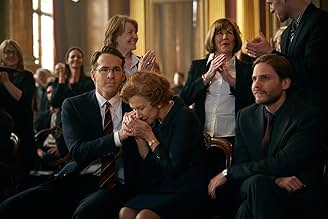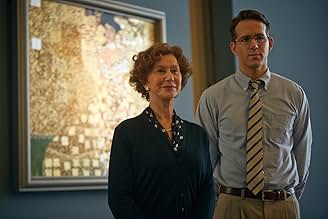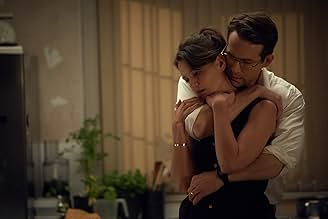Maria Altmann, an octogenarian Jewish refugee, takes on the Austrian government to recover artwork she believes rightfully belongs to her family.Maria Altmann, an octogenarian Jewish refugee, takes on the Austrian government to recover artwork she believes rightfully belongs to her family.Maria Altmann, an octogenarian Jewish refugee, takes on the Austrian government to recover artwork she believes rightfully belongs to her family.
- Director
- Writers
- Stars
- Awards
- 6 nominations total
- Director
- Writers
- All cast & crew
- Production, box office & more at IMDbPro
Featured reviews
The Woman in Gold is based on the true story about a woman, Maria Altmann (Helen Mirren), and her lawyer, Randol Schoenberg (Ryan Reynolds), as they attempt to reclaim ownership of an extremely valuable painting (along with a few more) form the Austrian government nearly fifty years after it was stolen by the Nazis. This film has three distinct parts that intertwine through the duration of the show. First, there is a family dynamic that focuses on the emotional stress of the current situation on everyone's personal lives. There is a strong connection between Randol and Maria that grows over time and is given time to grow in these segments. Second, there are flashbacks that dive deeper into Maria's past and emphasize the importance of the artwork as well as explore parallels between the past and the present. Finally there is the trial itself, which is where the action of the conflict lies. This is the least important, yet still necessary part of the story. The percentage of time given to these segments would be around 40/40/20, respectively. While you might be surprised how much of the story takes place in the past, it really does drive the plot. There are many white-knuckle scenes and heart wrenching moments that really add to the film. The past is just as important as the present in this movie, and that is exactly what the film is trying to say. Helen Mirren, as always, was amazing in this film. She was subtle and drove many of the scenes that required raw emotion. Ryan Reynolds was also very good and his role in this film might have been his best performance (from what I have seen). Actually, all of the actors did a fantastic job here. Everyone was on there A-Game and gave it everything they had. There was great chemistry between Mirren and Reynolds which made their characters' connection even more compelling. Reynolds was able to subtly change his character as the case slowly changed his motivations. While, yes, there are a few clichéd scenes that were put in there for emotional levity and drama, but they don't really take much away, if anything. This was an excellent film and I highly recommend it.
I thought that this was a very entertaining and informative film, which sets the scene naturally.
It was not overly dramatised or forced and with excellent performances; particularly from Helen Mirren and Tatiana Maslany who played the same character at different ages perfectly in harmony with each other; showing how history can change people from youthful optimism to pragmatism and a wistfulness for a glorious past.
History buffs will find it a fascinating foray into the glory of Vienna's past. Though art stolen by Nazis is a theme recently explored by movies such as The Monuments Men, this part of the Second World War has not been really explored by the movie industry; I am sure there are more stories to come. There have been a few movies about Austria and the Third Reich, the Sound of Music springs to mind. This one compares favourably with both the aforementioned films.
It was not overly dramatised or forced and with excellent performances; particularly from Helen Mirren and Tatiana Maslany who played the same character at different ages perfectly in harmony with each other; showing how history can change people from youthful optimism to pragmatism and a wistfulness for a glorious past.
History buffs will find it a fascinating foray into the glory of Vienna's past. Though art stolen by Nazis is a theme recently explored by movies such as The Monuments Men, this part of the Second World War has not been really explored by the movie industry; I am sure there are more stories to come. There have been a few movies about Austria and the Third Reich, the Sound of Music springs to mind. This one compares favourably with both the aforementioned films.
Helen Mirren and Ryan Reynolds star in "Woman in Gold" from 2015, a true story about the quest of Maria Altmann to recover art stolen from her family by the Nazis in Vienna, the seat of anti-Semitism in Europe.
I just want to point out, to answer some of the reviews, that this is not a documentary, it's a movie. Movies combine events, change them around, omit them. No one wants to watch a tedious film that recognizes that it took a huge amount of time to get to the Supreme Court. If you want the actual, factual story of Maria Altmann's journey, you will need to read about it or see one of several documentaries. Films are meant to pique our interest.
Altmann speaks with a young attorney, Randy Shoenberg, about recovering The Woman in Gold, a painting by Klimt that is considered a symbol of Vienna. Klimt in fact painted a series of stunning portraits of Altmann's aunt, Adele Bloch-Bauer, who died of meningitis at the age of 44.
In her will, she asked her husband Ferdinand, who had seen the writing on the wall in Vienna and fled to Prague, to donate the paintings to the Austrian State Gallery.
Although he has just started a new job, Shoenberg travels to Vienna to see the will. Along the way there are flashbacks of Vienna in the '30s, where the Bloch-Bauer family lived in opulence. When the Nazis came to their home, they stripped the place of everything valuable - and there was a lot -- and put the family under house arrest.
Maria and her husband, an opera singer, manage to escape in a harrowing scene. In flashbacks, Maria is played by the remarkable Tatiana Maslany, the star of "Orphan Black," who looks incredibly like a brunette Mirren.
This is a touching, beautifully told story of one man's sacrifice and determination and a woman facing up to her past in order to seek justice.
Helen Mirren is one of my favorite actresses - here, she is a vibrant, energetic octogenarian who finds the struggle for the painting uncomfortable - several times, meeting a roadblock, she is ready to wash her hands of it, but Schoenberg won't let her. It represents her family to her, and some uncomfortable memories. You can see all of that in Mirren's multilayered performance.
Reynolds is excellent as a young man who believes in taking a chance - - he started and failed in his own law practice - and in this case, going for the gold, despite the fact that he has a wife (Katie Holmes), a baby, and one on the way, and an intolerant boss. It doesn't faze him and when Maria wants to quit, he is furious.
I disagree that there was no connection between them. In fact, there is a deep one. The quest for the painting comes to represent to him what it means to Maria
I highly recommend this film. There are tons of movies about the horrors perpetrated on Jews by the Nazis. The recovery of stolen art is one part of that horror. "You see a painting," she tells a group. "I see my aunt."
I just want to point out, to answer some of the reviews, that this is not a documentary, it's a movie. Movies combine events, change them around, omit them. No one wants to watch a tedious film that recognizes that it took a huge amount of time to get to the Supreme Court. If you want the actual, factual story of Maria Altmann's journey, you will need to read about it or see one of several documentaries. Films are meant to pique our interest.
Altmann speaks with a young attorney, Randy Shoenberg, about recovering The Woman in Gold, a painting by Klimt that is considered a symbol of Vienna. Klimt in fact painted a series of stunning portraits of Altmann's aunt, Adele Bloch-Bauer, who died of meningitis at the age of 44.
In her will, she asked her husband Ferdinand, who had seen the writing on the wall in Vienna and fled to Prague, to donate the paintings to the Austrian State Gallery.
Although he has just started a new job, Shoenberg travels to Vienna to see the will. Along the way there are flashbacks of Vienna in the '30s, where the Bloch-Bauer family lived in opulence. When the Nazis came to their home, they stripped the place of everything valuable - and there was a lot -- and put the family under house arrest.
Maria and her husband, an opera singer, manage to escape in a harrowing scene. In flashbacks, Maria is played by the remarkable Tatiana Maslany, the star of "Orphan Black," who looks incredibly like a brunette Mirren.
This is a touching, beautifully told story of one man's sacrifice and determination and a woman facing up to her past in order to seek justice.
Helen Mirren is one of my favorite actresses - here, she is a vibrant, energetic octogenarian who finds the struggle for the painting uncomfortable - several times, meeting a roadblock, she is ready to wash her hands of it, but Schoenberg won't let her. It represents her family to her, and some uncomfortable memories. You can see all of that in Mirren's multilayered performance.
Reynolds is excellent as a young man who believes in taking a chance - - he started and failed in his own law practice - and in this case, going for the gold, despite the fact that he has a wife (Katie Holmes), a baby, and one on the way, and an intolerant boss. It doesn't faze him and when Maria wants to quit, he is furious.
I disagree that there was no connection between them. In fact, there is a deep one. The quest for the painting comes to represent to him what it means to Maria
I highly recommend this film. There are tons of movies about the horrors perpetrated on Jews by the Nazis. The recovery of stolen art is one part of that horror. "You see a painting," she tells a group. "I see my aunt."
Greetings again from the darkness. The responsibility of the filmmaker when the project is "based on a true story" is elevated when the story has significant historical relevance and blends such elements as art, identity, justice and international law. Add to those the quest of a remarkable woman whose family was ripped apart by Nazi insurgents, and more than a history lesson, it becomes a poignant personal story.
Helen Mirren portrays Maria Altmann, the woman who emigrated to the United States by fleeing her Austrian homeland during World War II, and leaving behind her beloved family and all possessions. After the death of her sister, Ms. Altmann becomes aware of the family artwork stolen by the Nazi's during the invasion. This is not just any artwork, but multiple pieces from famed Austrian artist Gustav Klimt including "Portrait of Adele Bloch-Bauer". See, Adele was Maria's aunt, and the stunning piece (with gold leaf accents) has become "the Mona Lisa of Austria", while hanging for decades in the state gallery.
The story revolves around Maria's partnering with family friend and upstart attorney Randol Schoenberg (Ryan Reynolds) to take on the nation of Austria and reclaim the (extremely valuable) artwork that was seized illegally so many years ago. They are aided in their mission by an Austrian journalist (played by Daniel Bruhl) who is fighting his own demons. The seven-plus year legal saga is condensed for the big screen and we follow Maria and Randol as they meet with the Austrian art reclamation committee, a federal judge (played by the director's wife Elizabeth McGovern), the U.S. Supreme Court (Jonathan Pryce as Chief Justice), and finally a mediation committee back in Austria. But this is not really a courtroom drama it's a personal quest for justice and search for identity. What role does family roots and history play in determining who we are today? It's the age old question of past vs. present, only this is seen through the eyes of a woman who has survived what most of us can only imagine.
Director Simon Curtis (My Week with Marilyn) uses startling flashbacks (with Tatiana Maslany as the younger Maria) to provide glimpses of Maria's childhood through her marriage and subsequent escape. We get to know her family, including some scenes featuring Aunt Adele (Antje Traue), and Maria's father and uncle (Henry Goodman, Allan Corduner). We understand this family's place in society and just how dramatically they were impacted by the Nazi takeover.
Helen Mirren delivers yet another exceptional performance and manages to pull off the snappy lines without an ounce of schmaltz, while also capturing the emotional turmoil Ms. Altmann endures. Director Curtis and writer Alexi Kaye Campbell round off some of the rough edges and inject enough humor to prevent this from being the gut-wrenching process it probably was in real life. This approach makes the film, the story and the characters more relatable for most movie goers and it's quite an enjoyable look at a fascinating woman and a pretty remarkable underdog story.
Helen Mirren portrays Maria Altmann, the woman who emigrated to the United States by fleeing her Austrian homeland during World War II, and leaving behind her beloved family and all possessions. After the death of her sister, Ms. Altmann becomes aware of the family artwork stolen by the Nazi's during the invasion. This is not just any artwork, but multiple pieces from famed Austrian artist Gustav Klimt including "Portrait of Adele Bloch-Bauer". See, Adele was Maria's aunt, and the stunning piece (with gold leaf accents) has become "the Mona Lisa of Austria", while hanging for decades in the state gallery.
The story revolves around Maria's partnering with family friend and upstart attorney Randol Schoenberg (Ryan Reynolds) to take on the nation of Austria and reclaim the (extremely valuable) artwork that was seized illegally so many years ago. They are aided in their mission by an Austrian journalist (played by Daniel Bruhl) who is fighting his own demons. The seven-plus year legal saga is condensed for the big screen and we follow Maria and Randol as they meet with the Austrian art reclamation committee, a federal judge (played by the director's wife Elizabeth McGovern), the U.S. Supreme Court (Jonathan Pryce as Chief Justice), and finally a mediation committee back in Austria. But this is not really a courtroom drama it's a personal quest for justice and search for identity. What role does family roots and history play in determining who we are today? It's the age old question of past vs. present, only this is seen through the eyes of a woman who has survived what most of us can only imagine.
Director Simon Curtis (My Week with Marilyn) uses startling flashbacks (with Tatiana Maslany as the younger Maria) to provide glimpses of Maria's childhood through her marriage and subsequent escape. We get to know her family, including some scenes featuring Aunt Adele (Antje Traue), and Maria's father and uncle (Henry Goodman, Allan Corduner). We understand this family's place in society and just how dramatically they were impacted by the Nazi takeover.
Helen Mirren delivers yet another exceptional performance and manages to pull off the snappy lines without an ounce of schmaltz, while also capturing the emotional turmoil Ms. Altmann endures. Director Curtis and writer Alexi Kaye Campbell round off some of the rough edges and inject enough humor to prevent this from being the gut-wrenching process it probably was in real life. This approach makes the film, the story and the characters more relatable for most movie goers and it's quite an enjoyable look at a fascinating woman and a pretty remarkable underdog story.
'Woman in Gold' makes for a dazzling movie experience (even if at times it may leave you questioning it's authenticity). Having not been an admirer of Mirren's early screen work - she seems to have become better with age (well, for me anyway), I was taken with her portrayal of Maria Altman from start to finish (as also in 'The Queen'). Ryan Reynolds gives good support as the young Lawyer taking on a case above his station. Reynolds, whose style is somewhat reminiscent of a young Kevin Costner, plays the Randol Schoenberg part with conviction.
London born director Simon Curtis gives the proceedings an easy to watch style and with the help of documentary editor Peter Lambert, they keep the viewer engaged throughout. Curtis also gets to direct his American wife (in a guest style role) Elizabeth McGovern, who has since made England her home. First time feature screenplay writer Alexi Kaye Campbell has fashioned an interesting interpretation of the writings of Altman and Schoeenberg's own life experiences, looking back at yet another of humanity's all time low past atrocities - although as mentioned, for some, certain sections of the screenplay may not always ring true (?)
Cinematographer Ross Emery (Matrix) gets a chance to prove he's also good without the help of tons of big budget CGI. It's hard to tell who did what with the music score, credited to both Martin Phipps and Hans Zimmer but, it's pleasing in an unobtrusive manor. Design Guru's, Andrew Ackland-Snow and brothers Dominic and Giles Masters (Harry Potter) with the help of others, ensure it looks good - perhaps while also getting a chance to strut their stuff without being drenched in CGI.
As a minor point, some location settings in Austria seemed a little too devoid of people to give an accurate representation, still, it's an amazing human story, both informative and entertaining. It should please most sophisticated audiences, while letting us reflect on an episode from our dark past.
London born director Simon Curtis gives the proceedings an easy to watch style and with the help of documentary editor Peter Lambert, they keep the viewer engaged throughout. Curtis also gets to direct his American wife (in a guest style role) Elizabeth McGovern, who has since made England her home. First time feature screenplay writer Alexi Kaye Campbell has fashioned an interesting interpretation of the writings of Altman and Schoeenberg's own life experiences, looking back at yet another of humanity's all time low past atrocities - although as mentioned, for some, certain sections of the screenplay may not always ring true (?)
Cinematographer Ross Emery (Matrix) gets a chance to prove he's also good without the help of tons of big budget CGI. It's hard to tell who did what with the music score, credited to both Martin Phipps and Hans Zimmer but, it's pleasing in an unobtrusive manor. Design Guru's, Andrew Ackland-Snow and brothers Dominic and Giles Masters (Harry Potter) with the help of others, ensure it looks good - perhaps while also getting a chance to strut their stuff without being drenched in CGI.
As a minor point, some location settings in Austria seemed a little too devoid of people to give an accurate representation, still, it's an amazing human story, both informative and entertaining. It should please most sophisticated audiences, while letting us reflect on an episode from our dark past.
Did you know
- TriviaOprah Winfrey was, for ten years, the owner of Gustav Klimt's second-most-famous portrait of the subject of the painting unofficially known as "Woman in Gold." The second most famous Klimt portrait of Bloch-Bauer was officially titled "Adele Bloch-Bauer ll." Winfrey reportedly bought the painting anonymously in 2006, when Christie's sold it at auction for $87.9 million, during the same auction session when the subject of this film was sold, along with four other Klimt paintings owned by Maria Altmann's family. In 2016, Winfrey sold the 54"x54" painting, "Adele Bloch-Bauer II," to a Chinese collector for $150 million.
- GoofsWhen Randy Schoenberg is before the Supreme Court, he is shown being asked a convoluted question by Chief Justice William Rehnquist, whereupon Schoenberg admits he doesn't understand it. That question was actually posed by Justice David Souter. The reaction from the other justices, who also didn't understand the question, was accurately depicted.
- Quotes
Randol Schoenberg: It's hard to believe Hitler once applied to be an art student here.
Maria Altmann: I wish they'd have accepted him.
- ConnectionsEdited into The Spoils (2024)
- How long is Woman in Gold?Powered by Alexa
Details
- Release date
- Countries of origin
- Official sites
- Languages
- Also known as
- La dama de oro
- Filming locations
- Production companies
- See more company credits at IMDbPro
Box office
- Budget
- $11,000,000 (estimated)
- Gross US & Canada
- $33,307,793
- Opening weekend US & Canada
- $2,091,551
- Apr 5, 2015
- Gross worldwide
- $61,619,773
- Runtime1 hour 49 minutes
- Color
- Sound mix
- Aspect ratio
- 2.35 : 1
Contribute to this page
Suggest an edit or add missing content









































